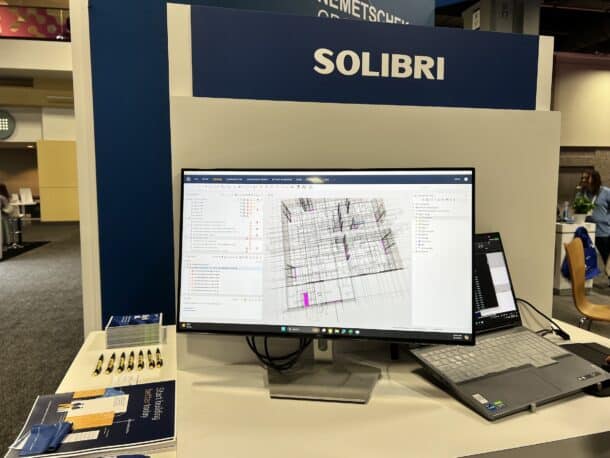The Nemetschek Group is our first subject in our show reports from the AIA National Convention in Washington, DC. This year featured its usual technology zone (called a pavilion in the past), but this year labeled the Innovation Zone.
The usual major AEC software companies were not only exhibiting on the show floor but held prime locations in the Innovation Zone itself or right adjacent to it. Chief among those were Autodesk and Chaos, and this year, the Nemetschek Group exhibited a half dozen of their leading brands in architecture in one unified massive booth area. Other key brands included Trimble (SketchUp), Lumion, Newforma, Snaptrude, and Unanet.
MORE: Architosh 10th ‘BEST of SHOW’ honors for digital technologies at AIA National Washington DC
Here are our highlights from what technology was shown at AIA24 this year.
Nemetschek Group Companies
The Nemetschek Group showed up this year with a massive booth the length of an entire block (from aisle to aisle) with its two dominant BIM platforms—Archicad and Vectorworks Architect—positioned at each end. There was a lot of traffic at the Nemetschek booth and a lot of spill-over traffic from the Autodesk booth sitting beside it.

Not all of these Nemetschek brands were at the Group booth this year but dRofus, dTwin, Solibri, Bluebeam, Archicad, and Vectorworks were all prominently featured. It is possible that these other brands were available to see under a Nemetschek Group section of the booth, but we didn’t have time to explore that fully.
Solibri was one of the first Nemetschek brands we talked to. Solibri is a BIM model checker application and has functional overlap in many areas with Autodesk Navisworks. While Navisworks is much more well-known in the United States AEC market and is part of the Autodesk ecosystem of AEC software tools, Solibri does have several advantages and many AEC customers in the United States actually use both products in their pipelines.

Solibri is the most comprehensive and flexible (rule-based) BIM model checker in the AEC software market. It is often used in conjunction with Autodesk Navisworks even though the two programs overlap and compete in the same space.
Unlike Navisworks, Solibri features a more comprehensive and flexible rule-based system for BIM model checking and lets users custom-define rules and conditions for various checks. This flexibility is Solibri’s superpower; it is the system you want if you wish to do very advanced and customized types of model checking. Solibri has a very nice user interface and model visualization capabilities. Another strength of the software is its ability to produce complex reports and its collaboration features. And Solibri can send issues in BCF (BIM collaboration format) as well as produce reports on issues in PDF, RTF and Excel. And speaking of issues, Solibri benefits from its BCF Live Connector to allows sending found issues to BIM issues managers like BIMcollab and BIMTrack.
The next Nemetschek daughter product we examined was dRofus; this year, we awarded dRofus a BEST of SHOW award in the BIM category. dRofus is used in large BIM projects for data-complex building types, including healthcare (think hospitals), colleges, and corporate buildings. The company is also interested in serving the needs of data centers as they balloon in construction due to AI.

dRofus is seen on the right running on the laptop and also on the left as a plugin inside Autodesk Revit.
As explained in our BEST of SHOW report, dRofus is a planning tool and facilities data tool and helps building stakeholders manage data across every aspect of a building, from its systems to its furniture. It can also connect to the sibling app Solibri. It ships as a standalone Windows application and has a web browser-based version. Architects working in Autodesk Revit and Graphisoft Archicad can install the dRofus plugin and, with that, can manage complex data around all objects inside a BIM model. There is also a mobile app for your smartphone and this enables dRofus to even function as a type of punch tool, as well as highly mobilizes facilities management professionals.
Vectorworks Architect 2024 was being shown at the giant Nemetschek Group booth. This year’s award-winning version boasts numerous interesting BIM modeling and editing features, many of which we covered in our rated product review published earlier this year.

Vectorworks Architect 2024 is seen on the screens. The Vectorworks booth area inside the larger Nemetschek booth saw a lot of traffic at AIA24.
We got a chance to sit down in the booth with Dr. Biplab Sarkar, CEO of Vectorworks, to chat about the future of the popular BIM-CAD platform used across numerous industries, in addition to Architecture. The company is looking at future AI technologies in several places in the application and has already utilized AI in the form of machine learning (ML) in several places. Future updates coming in the next version of Vectorworks include a new user-interface component that will help with 3D navigation—managing where you are in the model.
MORE: Product Review: Vectorworks Architect 2024
Dr. Biplab also mentioned that the Nemetschek Group had launched an AI Hub for all companies in the Group, and each company in the group was tasked with generating AI use cases. In total, more than 120 use cases for AI were generated, from which the most fruitful use cases will be pursued by the team behind the AI Hub. And speaking of that team and leadership, the Nemetschek Group’s AI Hub leadership includes two prominent AI researchers from Google.
Bluebeam was also a popular visit inside the giant Nemetschek Group booth. Bluebeam is the Nemetschek Group’s largest company in terms of actual license seats, with over 3 million users utilizing the product in over 160 countries. Bluebeam Revu is the company’s flagship desktop application and is used by architects, engineers, and construction professionals rather equally. It is arguably the only AEC industry PDF markup tool in existence of any stature, and so when the company announced it was stopping support of Bluebeam Revu for Mac a few years ago because they were pushing their solutions to the cloud, it rather upset a large set of Mac-based architects and other AEC professionals.

Look carefully; this is a 3D view of a building on a 2D drawing inside Bluebeam Cloud. But 3D Drawings is real 3D inside Bluebeam technology and is shown in the image below.
I spoke to Don Jacob, the company’s chief information officer and one-time CEO. Ron Close, the vice president of global marketing (who was recently in a similar role at Graphisoft), was also present. Jacob didn’t say much about the future of Bluebeam for Mac users, but he did acknowledge that the company is monitoring the situation with the rise of ARM-chip-based Windows PCs and the slew of new laptops emerging this year branded Microsoft Copilot+ PCs. Those computers—all mobile laptops for the most part—will be powered by Qualcomm’s Snapdragon Elite ARM chip and will rival and, in some cases, exceed the performance of Apple’s industry-leading MacBook line of computers. What this means, without really saying it, is if these ARM-based Windows computers take off and Bluebeam decides to re-write Bluebeam Revu for them natively (converting Intel X86 code to ARM code), it is conceivable that they might do the extra work to reach ARM Macs.
But here is something that Don Jacob and Bluebeam leadership need to listen to. While at AIA24, we visited the Dell booth—yes! Dell was the lone hardware vendor at the show, and they had a nice display of some great hardware (mostly laptops). In talking to the Dell folks, they said their new ARM-based Microsoft Copilot+ PCs are coming mid-summer, and they are tremendously powerful. In other words, much faster than any Intel-based mobile laptop computer with battery life that is up to 3x longer than what Intel can actually deliver. The ARM Windows laptops are “game changers” and will sell in huge numbers and begin to change the Windows ecosystem.
Back to Bluebeam. Microsoft is making a big push with the new ARM-powered Microsoft Copilot+ PCs. Windows on ARM will ship with its own version of an Intel emulator (think Apple Rosetta 2 for Windows), and so, depending on how fast that emulator is, Bluebeam Revu may actually run rather okay without being converted to ARM code. If that is the case, expecting a native return of Bluebeam Revu for Mac is rather hopeless.

I have to admit, seeing 3D Drawings inside Bluebeam Cloud was exciting. It also reminded me of the way 2D drawings are shown inside the transition between drawings and the BIM model in BIMx.
Today, Mac users are expected to leverage Bluebeam Cloud. Don Jacob said that upcoming improvements to Bluebeam Cloud will give more power to markup and measurement inside the Cloud. At the moment, you cannot calibrate and measure in Bluebeam Cloud. There is also no compare feature in Bluebeam Cloud. While the markup tools in the cloud are rather solid, there is still too much missing to make it a real substitute for Revu on the desktop. Jacob also showed us 3D Drawings for Bluebeam, which was rather exciting to see. Essentially, 3D Drawings—which operates in Bluebeam Cloud—automatically coordinates 2D drawings like exterior elevations and building sections and places those vertically in a 3-dimensional view, along with plan drawings. (see image above). From there, users can get a more comprehensive view of a building, which aids in coordination.
Architosh now wants to explore 3D Drawings in Bluebeam Cloud fully so we can understand its benefits more fully.
This completes our first report from the show floor. In our second report, we’ll cover Graphisoft’s Archicad, BIMx, and its AI exhibit. Plus Autodesk. Stay tuned!
next page > More Nemetschek Booth companies and Autodesk (link coming up!)


